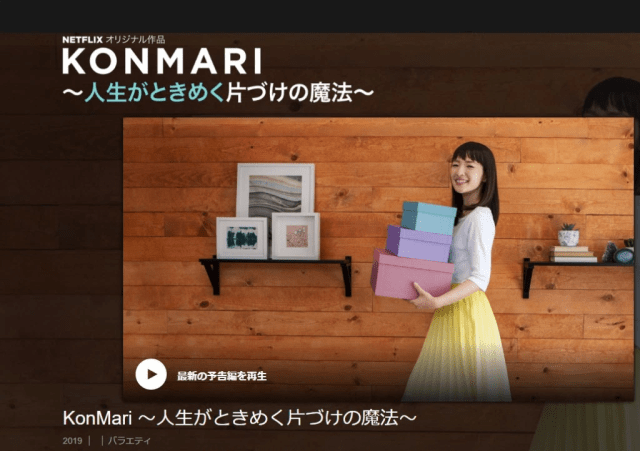
With a new Netflix series streaming on both sides of the Pacific, our reporter ponders what America sees in Japan’s tidying-up master.
With Netflix now available in Japan, there’s something interesting going on right now as the country gets to see Tokyo native Marie Kondo applying her methods for tidy living, developed while living in compact Japanese homes, to the much larger canvas of American living spaces via her Tidying Up with Marie Kondo series.
Our Japanese-language reporter Yayoi recently started watching the series, but at first she wasn’t sure why Americans would be interested in the teachings and techniques of Konmari, as she’s popularly known in Japan. After all, don’t all Americans live in huge houses, like the ones you see in Hollywood movies?
Of course, that’s not the case, and while watching Yayoi also learned that while American homes are, on average, much larger than their Japanese counterparts, bigger homes tend to lull you into buying bigger stuff, leading to just as much clutter as you’d have in a smaller house or apartment. At the same time, she also came across what she thinks are three secrets to the booming overseas popularity of Kondo and her new series.
First, right from the get-go Yayoi thinks that Kondo’s Netflix series does an excellent job of selecting who she’s going to help. Episode one focuses on a family where both husband and wife work, but still want a tidy home for themselves and their two children. Yayoi thinks this scenario, and the desire to create an organized, stress-free living space even without much time to dedicate to the task, is universally understandable, transcending national borders.
But at the same time, Yayoi thinks that Kondo’s foreign-country origin makes a lot of her ideas feel extra-novel to an American audience. For example, many of the people she helps are impressed at the space savings that can come from precise folding of clothes, or placing boxes or dividers inside drawers to sub-compartmentalize them and maximize their utility and efficiency. “In the U.S., I think it’s the norm to have larger closets than we do in Japan,” muses Yayoi, “and those sorts of techniques haven’t taken root in modern culture as strongly as they have in Japan [where they’re often done as a matter of course].”
As a matter of fact, Yayoi also thinks there’s a little bit of showmanship in Kondo’s onscreen demeanor and mannerisms, which help to give her a Zen master-like aura. “In the show, when Kondo says thank you to someone, I sometimes see her pressing her hands together in front of her face as she bows…but in Japan, we really don’t do this very often at all.” Other unusual yet impression-leaving behavior Kondo displays include kneeling Japanese-style on the floor of the home, closing her eyes like she’s about to meditate, and bowing deeply in order to “greet the home” before she gets to work, as well as talking to clothing as she folds it. Neither of those are anything close to the norm in Japan, but they help establish Kondo as someone who’s operating on an advanced level psychologically/spiritually, and add a dramatic flair, plus some cute fun, to the ordinarily dry and dull task of cleaning and cutting clutter.
So while Kondo’s series isn’t 100-percent representative of the mainstream Japanese attitude about tidying up, it’s got enough Japanese concepts to feel fresh to American viewers, and Kondo herself is able to present them in an engaging way with a contagious enthusiasm, which is no small feat, even when working with big houses.
Top image: Netflix
[ Read in Japanese ]

 The Marie Kondo story: How a Japanese girl became an overnight celebrity with a hit show on Netflix
The Marie Kondo story: How a Japanese girl became an overnight celebrity with a hit show on Netflix Marie Kondo helps Donald Trump tidy up the White House 【Video】
Marie Kondo helps Donald Trump tidy up the White House 【Video】 KonMari’s YouTube reveals interesting fact about Japanese vs. non-Japanese online preferences
KonMari’s YouTube reveals interesting fact about Japanese vs. non-Japanese online preferences “Tidying up” master Marie Kondo sparks controversy, not joy, by opening online knick-knack shop
“Tidying up” master Marie Kondo sparks controversy, not joy, by opening online knick-knack shop Tidying expert Maire Kondo teams up with budget store 3Coins for a home organization line
Tidying expert Maire Kondo teams up with budget store 3Coins for a home organization line Japanese beef bowl chain Sukiya’s 2026 Smile Box lucky bag basically pays for itself
Japanese beef bowl chain Sukiya’s 2026 Smile Box lucky bag basically pays for itself Majority of Japanese mayors say foreign residents are essential but most see good and bad effects
Majority of Japanese mayors say foreign residents are essential but most see good and bad effects Four Shinto shrines to pray for love at in Japan to start the New Year
Four Shinto shrines to pray for love at in Japan to start the New Year Should you dip your cake in sake? One Japanese brewer says no, but actually yes【 Taste test】
Should you dip your cake in sake? One Japanese brewer says no, but actually yes【 Taste test】 Village Vanguard’s most expensive Black Lucky Bag sets an ominous tone for 2026
Village Vanguard’s most expensive Black Lucky Bag sets an ominous tone for 2026 Survey finds more than 70 percent of Japanese children have an online friend
Survey finds more than 70 percent of Japanese children have an online friend Japanese avoiding domestic travel as foreign tourists increase, possibly creating vicious cycle
Japanese avoiding domestic travel as foreign tourists increase, possibly creating vicious cycle We use the Seishun 18 Ticket to travel from Japan to Korea by ferry
We use the Seishun 18 Ticket to travel from Japan to Korea by ferry Japan’s first hotel with a human washing machine is now ready for you to come and bathe in it
Japan’s first hotel with a human washing machine is now ready for you to come and bathe in it Why Sensoji temple in Asakusa is better at night
Why Sensoji temple in Asakusa is better at night Starbucks Japan ready to get Year of the Horse started with adorable drinkware and plushies【Pics】
Starbucks Japan ready to get Year of the Horse started with adorable drinkware and plushies【Pics】 Hayao Miyazaki says Happy New Year to Studio Ghibli fans with new art for Year of the Horse
Hayao Miyazaki says Happy New Year to Studio Ghibli fans with new art for Year of the Horse 7 great places to see Mt. Fuji from without having to climb it
7 great places to see Mt. Fuji from without having to climb it We found possibly the quietest Japanese-style hotel in Tokyo’s bustling Shinjuku district
We found possibly the quietest Japanese-style hotel in Tokyo’s bustling Shinjuku district Cup Noodle tries an authentic Jiro-style ramen, but something’s not quite right
Cup Noodle tries an authentic Jiro-style ramen, but something’s not quite right Hello Kitty Choco Egg figures are an adorable trip through three periods of Japanese pop culture【Pics】
Hello Kitty Choco Egg figures are an adorable trip through three periods of Japanese pop culture【Pics】 Japan’s oldest largetooth sawfish in captivity back on display in Mie Prefecture
Japan’s oldest largetooth sawfish in captivity back on display in Mie Prefecture Cyberpunk anime meets traditional culture in Ghost in the Shell gold leaf Japanese changing screens
Cyberpunk anime meets traditional culture in Ghost in the Shell gold leaf Japanese changing screens The best Starbucks Japan Frappuccinos we want to drink again in 2026
The best Starbucks Japan Frappuccinos we want to drink again in 2026 We revisited Sweets Paradise after a decade to see if Japan’s dessert buffet still delivers
We revisited Sweets Paradise after a decade to see if Japan’s dessert buffet still delivers 7-Eleven Japan starts new temporary luggage storage service in over 300 branches
7-Eleven Japan starts new temporary luggage storage service in over 300 branches Disillusionment at Tsukiji’s tourist-target prices led us to a great ramen restaurant in Tokyo
Disillusionment at Tsukiji’s tourist-target prices led us to a great ramen restaurant in Tokyo Starbucks teams up with 166-year-old Kyoto doll maker for Year of the Horse decorations【Photos】
Starbucks teams up with 166-year-old Kyoto doll maker for Year of the Horse decorations【Photos】 Tokyo considering law requiring more trash cans following litter increase in heavily touristed area
Tokyo considering law requiring more trash cans following litter increase in heavily touristed area Tokyo’s Tsukiji sushi neighborhood asks tour groups to stay away for the rest of the month
Tokyo’s Tsukiji sushi neighborhood asks tour groups to stay away for the rest of the month Tokyo event lets you travel back in time, for free, to celebrate 100 years since Showa era start
Tokyo event lets you travel back in time, for free, to celebrate 100 years since Showa era start Sanrio theme park in Japan announces plans to expand into a Sanrio resort
Sanrio theme park in Japan announces plans to expand into a Sanrio resort Japan may add Japanese language proficiency, lifestyle classes to permanent foreign resident requirements
Japan may add Japanese language proficiency, lifestyle classes to permanent foreign resident requirements Stamina-destroying “Paralysis Noodles” are Tokyo’s newest over-the-top ramen innovation
Stamina-destroying “Paralysis Noodles” are Tokyo’s newest over-the-top ramen innovation Survey asks foreign tourists what bothered them in Japan, more than half gave same answer
Survey asks foreign tourists what bothered them in Japan, more than half gave same answer Japan’s human washing machines will go on sale to general public, demos to be held in Tokyo
Japan’s human washing machines will go on sale to general public, demos to be held in Tokyo Japan’s deadliest food claims more victims, but why do people keep eating it for New Year’s?
Japan’s deadliest food claims more victims, but why do people keep eating it for New Year’s? We deeply regret going into this tunnel on our walk in the mountains of Japan
We deeply regret going into this tunnel on our walk in the mountains of Japan Studio Ghibli releases Kodama forest spirits from Princess Mononoke to light up your home
Studio Ghibli releases Kodama forest spirits from Princess Mononoke to light up your home Major Japanese hotel chain says reservations via overseas booking sites may not be valid
Major Japanese hotel chain says reservations via overseas booking sites may not be valid Put sesame oil in your coffee? Japanese maker says it’s the best way to start your day【Taste test】
Put sesame oil in your coffee? Japanese maker says it’s the best way to start your day【Taste test】 No more using real katana for tourism activities, Japan’s National Police Agency says
No more using real katana for tourism activities, Japan’s National Police Agency says Starbucks Japan reveals new sakura drinkware collection, inspired by evening cherry blossoms
Starbucks Japan reveals new sakura drinkware collection, inspired by evening cherry blossoms Updated cherry blossom forecast shows extra-long sakura season for Japan this year
Updated cherry blossom forecast shows extra-long sakura season for Japan this year Have Marie Kondo help you organize your bathroom with her newest budget-friendly storage line
Have Marie Kondo help you organize your bathroom with her newest budget-friendly storage line Japanese company proposes Marie Kondo as mascot for new “Spark Joy” police taser weapons
Japanese company proposes Marie Kondo as mascot for new “Spark Joy” police taser weapons What’s wrong with Netflix’s live-action Cowboy Bebop? The characters, our old-school fan says
What’s wrong with Netflix’s live-action Cowboy Bebop? The characters, our old-school fan says
Leave a Reply